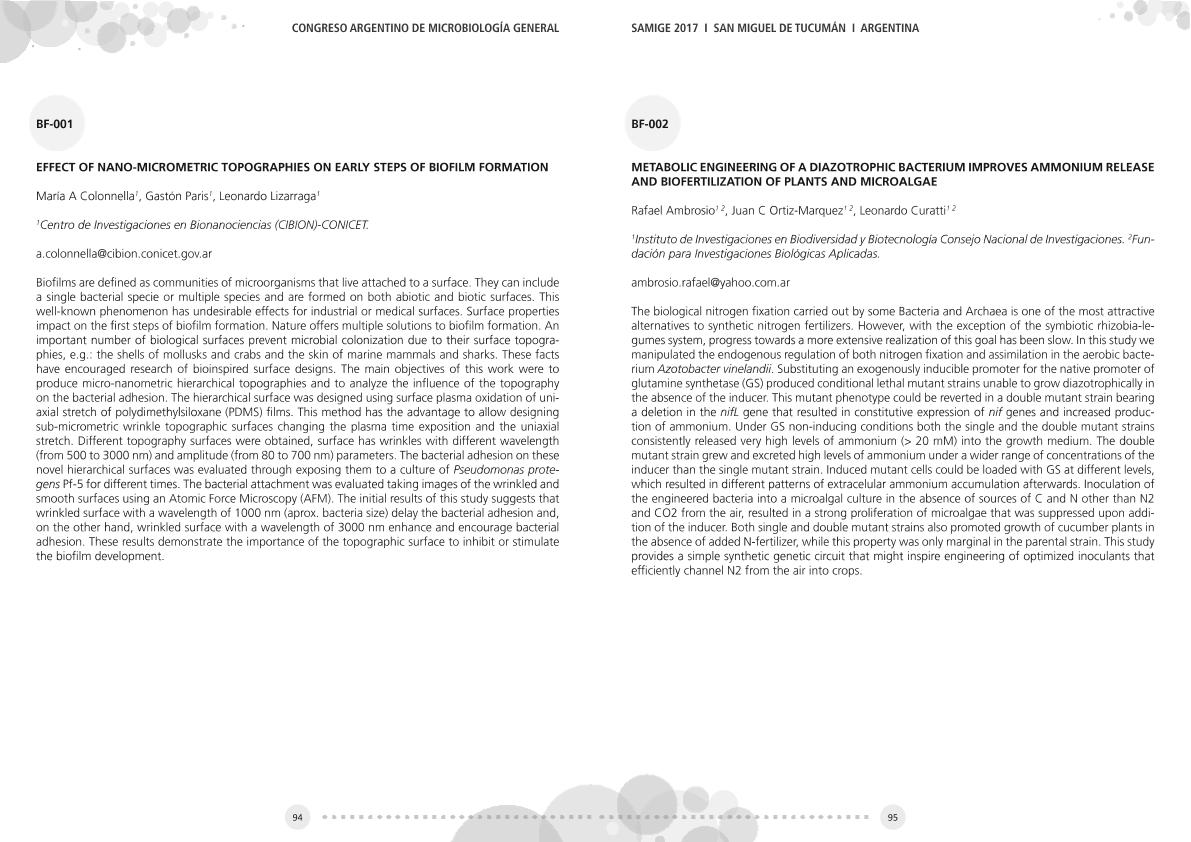Evento
Effect of nano-micrometric topographies on early steps of biofilm formation
Tipo del evento:
Congreso
Nombre del evento:
XII Congreso Argentino de Microbiología General
Fecha del evento:
02/08/2017
Institución Organizadora:
Sociedad Argentina de Microbiología General;
Título del Libro:
Libro de resúmenes: XII Congreso Argentino de Microbiología General
Editorial:
Sociedad Argentina de Microbiología General
Idioma:
Inglés
Clasificación temática:
Resumen
Biofilms are defined as communities of microorganisms that live attached to a surface. They can include a single bacterial specie or multiple species and are formed on both abiotic and biotic surfaces. Thiswell-known phenomenon has undesirable effects for industrial or medical surfaces. Surface properties impact on the first steps of biofilm formation. Nature offers multiple solutions to biofilm formation. Animportant number of biological surfaces prevent microbial colonization due to their surface topographies, e.g.: the shells of mollusks and crabs and the skin of marine mammals and sharks. These facts have encouraged research of bioinspired surface designs. The main objectives of this work were to produce micro-nanometric hierarchical topographies and to analyze the influence of the topography on the bacterial adhesion. The hierarchical surface was designed using surface plasma oxidation of uni-axial stretch of polydimethylsiloxane (PDMS) films. This method has the advantage to allow designing sub-micrometric wrinkle topographic surfaces changing the plasma time exposition and the uniaxial stretch. Different topography surfaces were obtained, surface has wrinkles with different wavelength (from 500 to 3000 nm) and amplitude (from 80 to 700 nm) parameters. The bacterial adhesion on these novel hierarchical surfaces was evaluated through exposing them to a culture of Pseudomonas protegens Pf-5 for different times. The bacterial attachment was evaluated taking images of the wrinkled and smooth surfaces using an Atomic Force Microscopy (AFM). The initial results of this study suggests thatwrinkled surface with a wavelength of 1000 nm (aprox. bacteria size) delay the bacterial adhesion and, on the other hand, wrinkled surface with a wavelength of 3000 nm enhance and encourage bacterial adhesion. These results demonstrate the importance of the topographic surface to inhibit or stimulatethe biofilm development.
Palabras clave:
Biofilm
,
Pseudomonas protegens
,
Nanostructures
,
AFM
Archivos asociados
Licencia
Identificadores
Colecciones
Eventos(CIBION)
Eventos de CENTRO DE INVESTIGACIONES EN BIONANOCIENCIAS "ELIZABETH JARES ERIJMAN"
Eventos de CENTRO DE INVESTIGACIONES EN BIONANOCIENCIAS "ELIZABETH JARES ERIJMAN"
Citación
Effect of nano-micrometric topographies on early steps of biofilm formation; XII Congreso Argentino de Microbiología General; Tucumán; Argentina; 2017; 1-1
Compartir




